Thanks for those who wrote nice notes or ordered books from us in response to that list of important memoirs I reviewed in BookNotes last week. As I mentioned, in some cases, these books really meant a lot to me, personally — we hope you enjoyed our comments about them. What a privilege to get to explain these passionate, often eloquent, well-crafted narratives of somebody’s life. Whether about a person who is famous or not, we can get lost in this kind of story, as with fiction, swept into its pathos and joy and longing and hope. And you’re sure to learn a bit, too. Please take a look at that list if you missed it. We would be grateful.
As promised, there are more.
I love the lines from an old Bruce Cockburn song, “Great Big Love” (from Nothing But a Burning Light) that goes:
Seen a lot of things in the world outside
Some bad but some good stuff too
Felt the touch of love in the works of God
And now and then in what people do
Never had a lot of faith in human beings
But sometimes we manage to shine…
I’ve read a lot of these kinds of books of memoir for my own personal enjoyment this past year and I’ve been eager to tell you about them. There’s some bad, but some good stuff, too. And, as Cockburn put it, “sometimes we manage to shine…” Some of these are simply stunning, several offer some of the most unforgettable writing I’ve encountered in years. Some of these stories may not appeal to you at first, but I’m confident they are worthy of being read and discussed.
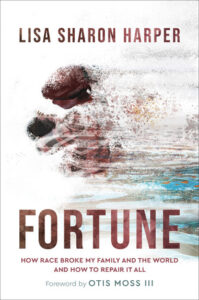 AND — I described it at the end of this post, but do consider pre-ordering the February 2022 release of Fortune: How Race Broke My Family and The World and How to Repair It All by our friend Lisa Sharon Harper (Brazos Press) $24.99 OUR SALE PRICE = $19.99 Not Yet Released: DUE FEBRUARY 8, 2022.
AND — I described it at the end of this post, but do consider pre-ordering the February 2022 release of Fortune: How Race Broke My Family and The World and How to Repair It All by our friend Lisa Sharon Harper (Brazos Press) $24.99 OUR SALE PRICE = $19.99 Not Yet Released: DUE FEBRUARY 8, 2022.
ALL BOOKS LISTED ARE 20% OFF, TOO. As always, just click on the “order” link at the very end of this newsletter which will take you to our secure order form at our Hearts & Minds website. It’s our pleasure to help. Thanks for caring.
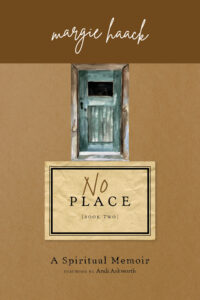 No Place: A Spiritual Memoir Margie Haack (Square Halo Books) $24.99
No Place: A Spiritual Memoir Margie Haack (Square Halo Books) $24.99
OUR SALE PRICE = $19.99
I want to start this second lists of our favorite memoirs this year by naming again a book I reviewed a half a year ago, long before it came out. We took quite a lot of pre-orders (and the dear author, the exceptional Margie Haack, got her loyal followers to order books through us.) So this has been — along with the biography of Eugene Peterson by Winn Collier called A Burning in My Bones — one of our biggest sellers of 2021. We are glad, too, as it is a great read, fun, interesting, well-written and very inspiring. You can see my review from when we first announced it HERE.
For those who want the reminded, No Place is the second volume in a trilogy, the first which will very soon be re-issued in a newly edited and expanded edition with a new cover matching No Place. That one is called The Exact Place and tells of the hardscrabble upbringing of Margie’s girlhood in the far rural north of Minnesota. She narrates her own young life and a rather unique upbringing in a poor shotgun shack (with a pretty rough family) which, as she puts it, was “the exact place” she needed to be, for, as they say, the next steps on her journey. For her, these essential steps turned into a life-changing realization of the saving goodness of God and a commitment to Jesus Christ and a desire to trust Him with the rest of her life. Without typical piety or sentimentalism, The Exact Place is a powerful spiritual memoir of a smart girl from a poor, working class family coming to vibrant faith. We very highly recommend it for those who like these sorts of personal stories.
The new one, No Place, is even more interesting and covers the next phrase of her life. This includes her early university years starting in 1965 (ill prepared as she may have been given that her family did not send children to college), her meeting the rather unusual Denis Haack, and their courtship and marriage in, as I recall, 1968. What a story!
The next period of the book includes their work in a fundamentalist door to door urban evangelism ministry — hot time, summer in the city, ya know — which was alienating and awful. She writes about this wonderfully, colorfully. Their faith grew and faltered, their marriage faced tension, and we learn a bit about Denis’s fairly dysfunctional childhood, the son of a very strict fundamentalist missionary. Even their weird door to door evangelism efforts were not respected by Margie’s father-in-law for some odd reason — he didn’t approve of the para-church group, he didn’t like somebody theologically, most likely Denis’s attire and moderate, late 60s haircut wasn’t conservative enough. What a painful and hard way to start off a young marriage. If you know their joyful and culturally aware lifestyle and ministry now (thanks especially to the influence of Francis and Edith Schaeffer, for starters) you would hardly believe this is how they used to be. I really believe, whether you know them and their creative ministry now or not, this book is illuminating of a life lived for God, but with unusual beginnings and eccentric twists and turns.
Set in the late 60s and early 70s as it may be, the issues for us all are not that different: how to discern what constitutes healthy Christian doctrine and life? How does our worldview inform us in life-giving ways? What should we think about the trends of the culture? How do we build bridges with non-believing neighbors? How do we create in our own homes and lifestyles signposts of beauty and goodness pointing towards God’s truth? No Place is a stimulating retro story, but — believe me! — it’s incredibly relevant, yet today.
Part way through the story, the twists and turns become harder and wilder. They end up rejecting much of this pushy sort of works-righteousness, holier-than-thou, anti-cultural attitudes of the ministry they were working with and, more generally — as they were coming to see — American fundamentalism more generally, and they set out in evangelical fervor to join what some call the Jesus movement.
They were drawn to a vision of reaching hippies and druggies out in a commune in the high deserts of New Mexico, along the legendary hippy trail to San Francisco, actually. Their efforts and experience at His House, as they called their community were set in a very different sort of faith experience and is vividly told; you will be on the edge of your seat. Through it all there is this question of the relationship of Christ to culture, of what some might call missional contextualization. Driven by the Spirit and flying blind by the seat of their pants (add another cliched metaphor in there anyone?) this season was both frightening and fruitful. They seemed born to do this sort of ministry, reaching out to those cast out from and often despised by conventional churches. They had found a calling. Deep hunger, deep gladness, indeed.
Of course, it necessarily comes undone and other jobs need to be found. They have a baby, Denis becomes a janitor, then does some working at a church that was less than ideal for them. Another baby, a connection made doing campus ministry with IVCF. On the story goes and it is wonderfully crafted, well-told, and very interesting. Margie is unsparing about their own personal and relationship difficulties, family stuff, finances and more. It is, as a good memoir must be, honest and captivating and in a nonintrusive way, instructive.
I can’t say enough about this book and highly recommend No Place, whether you’ve read The Exact Place first or not. It is a great story, a great read, a fine recent book.
There are some very good endorsements on the inside of this handsome paperback. Andi Ashworth of ArtHouse Nashville wrote the great forward and others who have raved include Katy Bowser, Nancy Nordenson, Donald Guthrie, Mark Ryan, and yours truly. Here is what I said:
There are memoirs that are so interesting and well written that one just enjoys spending time within the story they tell. There are others where the author has learned much, perhaps the hard way, and we are wise to listen in, absorbing her hard-won truths. And there are those that are sheer testimony, giving glory to God who seems the real actor in the story’s drama. It is rare when a memoir is all three, and Margie Haack’s No Place is thankfully one of these rare treats that is fun to read, offers profound wisdom, and through which we learn much about the God who is there.
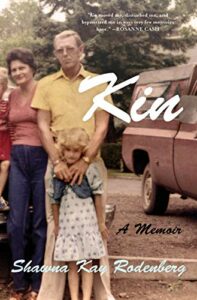 Kin: A Memoir Shawna Kay Rodenberg (Bloomsbury) $28.00
Kin: A Memoir Shawna Kay Rodenberg (Bloomsbury) $28.00
OUR SALE PRICE = $22.40
I’m not sure what initially drew me to this story mostly set in Appalachia — perhaps the prestige of the publisher (assuring me it would be at least well written and thoughtful) or the enticing blurbs like this from Bonnie Jo Campbell, author of Mothers, Tell Your Daughters, who promised:
“This startling memoir of a wild soul will electrify you. The unbreakable Shawna Kay rises again and again to forgive, despite every institution that failed her.”
Or, this, from Rosanne Cash:
Kin moved me, disturbed me, and hypnotized me in a way very few memoirs have.
I know Ms Cash is especially literate and has endorsed another memoir or two that were remarkable. She, like many of the other reviewers, have noted that this story is written as “an intimate portrait of hardscrabble life in a much-derided, little understood place.” Michael Patrick Smith (author himself of The Good Hand) continues:
With the grit of the damaged yet hopeful, Rodenberg crafts the raw notes of faith, addiction, and generational trauma into a hymn to survival. By focusing on the deeply personal lived experience of a family, Kin contains worlds.
Indeed, it “contains worlds.” Like other memoirs of abuse and complications of family and place, you may not exactly imagine yourself there, and yet, yet, you relate. There are universal themes here, including a love of place, shame about poverty, relationships that are toxic, religion, faith, spirituality, education, culture, and adult children loving their parents despite the often horrible mistakes. And — oh, my — forgiveness. Who wouldn’t benefit, or at least be stimulated if not inspired, by looking over the shoulder at one truly memorably family coping with so much grit and grace?
As yet another reviewer noted, Shawna Kay Roderberg’s “American original, so full of ballsy intelligence and unremitting love… feels like secular Scripture.”
Here’s the deal with this complicated, well-written story. First, you should know that Shawn had a very hard upbringing with hard-scrapple extended family in small towns among the mountains of Appalachia. She is now a somewhat sophisticated, college literature professor in another State and the book opens as she is serving as a liaison to the local folk in the holler with a big city TV crew doing some kind of documentary. The New Yorkers disdain for the local people (and their crass stereotypes, asking her to help them find shots that simulated the hillbilly optics they wanted) is exceedingly annoying and Shawna Kay’s keen capacity to relate to two different worlds is obvious. I do not make comparisons of the people or even the books, but because many readers will get the reference, I suggest that she is, in some ways, like Tara Westover of Educated and J.D. Vance of Hillbilly Elegy and, more recently — in some surprising ways — perhaps even Philip Yancey of Where the Light Fell.
Many of our customers had pre-ordered Where the Light Fell and some have finished it already. Some are amazed at his harsh mother, super-spiritual Bible teacher that she was, the toxic religion he endured amid Southern, small town poverty. Yancey says to his anguished brother — and to all of us, I suppose — that his story isn’t as bad as some, that the hard physical punishment he received and the strict fundamentalism he was taught could have been much worse.
Kin narrates a story that was “much worse.” And not only worse, but much more weird.
You see, Shawna Kay Roderberg (who tells her story with “near heroic self-awareness and insight,” as one reviewer put it) was raised on-again, off-again, in a very strict fundamentalist cult in Minnesota. Or, if not a cult, at least an expression of exceptional Pentecostalism and hyper-fundamentalism that drew her parents to live in a sectarian community, off the grid, prepping for the end times. She was raised — at least during her time in the fellowship — on a rural compound, eating meals in what sounds like a church camp setting, living in cottages that are meagerly appointed and hardly heated. This in the late 1970s and 80s, with parents who renounced the world and forbade their children most toys and books and most contact with the outside world. How her parents go into this heavy Bible teaching of Reverend Sam Fife is another part of the story and the ways she appreciated and hated the rules of the place are fascinating. (To say Shawna is precocious is quite the understatement!) I don’t want to say too much as I don’t want to spoil this adventure of a read, but it is playful and funny at times, horrible and horrific at others. They believe in corporal punishment, of course, and there are some harsh scenes of serious abuse (and other bizarre stuff that seems almost expected in these kind of highly authoritarian religious sects.) Even when they move away (backsliding, as they might call it) they connect yearly with others in this network at larger gatherings.
I hope I’m not saying too much when I hint that her parents themselves have an epiphany or two about the heavy-handed and anti-worldly fellowship. They get a job serving the movement away from the intentional community and, on some days, allow a more normal lifestyle. Their faith wavers, they fall away, they move back to Appalachia.
And we thought the people in the Minnesota sect were toxic and odd. Well, man, this story is just heating up.
Shawna, knowing little about 80s junior and senior high fashion, let alone popular culture, enters her school in Eastern Kentucky.
Shawna was permitted and has nearly memorized from repeated re-readings the Little House on the Prairie books and the way those stories keep coming up is a fun device. It is a part of her childhood that she clings to even as she gets older. The narration of her years in school back in small town Kentucky — learning how more ordinary rural kids live in public schools, enjoying time at DQ and Pizza Hut and going to the Dollar Store and school events and attending more ordinary country churches — is striking. How little she knows about school life, popular culture, attire, even. Not to mention, shall we say, sex, drugs and rock and roll. But she is a fast learner. So there’s that.
To make matters worse, although it is not explored in detail, there are hints of PTSD from her father’s Viet Nam war service. Which perhaps explains some things…
This family is troubled, and various branches of their relatives have their strengths and weaknesses. It will keep you turning the pages, I promise. Rodenberg both makes Appalachian life and near poverty vivid and compelling but her story dispels many stereotypes (even as it might reinforce others.) Her angle of vision and the tone of the book is decidedly not Hillbilly Elegy. I love the blurb on the back of Kin, that says, “Whatever you believe about Appalachia, prepare to have those beliefs upended, or at least beautifully complicated.”
Beautifully complicated. That’s it! Kin and my feelings about why I loved it so are beautifully complicated.
This recent book, dear readers, is a high-octane memoir full of vivid descriptions, colorful stories (and colorful language) telling of the struggles of deep faith, distorted as it may be, family love and dysfunction, violence and harm and goodness and redemption. Can telling a story like this itself be an act part of hope, what too many reviewers too casually call redemption? I think so. In that sense the above-quoted writer who said this is “secular Scripture” is wrong. It is not Scripture, of course, but it is not utterly secular either. This is a story of some sort of amazing grace and through the ups and downs, extravagant weirdness, family mental illness and unreliable choices, the story shines.
I liked this part of a review, yet another celebrating Kin as a well written and important read:
I hope this book will fall into the hands of everyone who has ever swallowed their words, hid their scars, been mocked, laughed at, or ignored. Rodenberg’s lyricism, mastery of form, and command of image and metaphor are matched only by the power of her honesty and the precision of her recall. Kin will endure and bring light and warmth to all who encounter this beautiful book. – Robert Gipe, author of the Canard County illustrated novel series, Trampoline, Weed Eater, and Pop
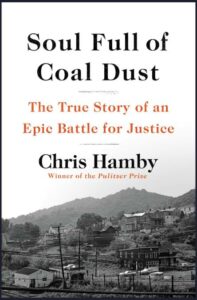 Soul Full of Coal Dust: A Fight for Breath and Justice in Appalachia Chris Hamby (Little, Brown) $30.00
Soul Full of Coal Dust: A Fight for Breath and Justice in Appalachia Chris Hamby (Little, Brown) $30.00
OUR SALE PRICE = $24.00
I have written several drafts of a review of this book which was one of the most striking books I’ve read all year; I do not have the space to do it justice. One can hardly believe the captivating detail, the plot that just gets thicker, the heroic tenacity and character of Mr. Hamby as he studies the problems of a seemingly sudden rise in Black Lung disease being uncovered in certain mining towns in West Virginia, and how miners and their families were denied what seemed to be their obvious, legally entitled reimbursement. (There are, you will learn, some reasons for this unexpected uptick in Black Lung in the late-1990s related to both changes in policy and measuring metrics, new mining technologies with different sorts of dust and dangers, and good, old-fashioned human corruption and carelessness.) Some tried to fight the surreal injustice of getting their due but their cases consistently were denied, unsuccessfully litigated by rural legal aid clinics in Appalachia. Both the disease and the injustices became epidemic.
I have a grandfather who had been a coal miner in Pennsylvania and who died from complications of Black Lung. I so wish my own father was alive to tell me more of Pappy Nip and his conditions — my memories of him and his illness are disturbing; near the end of his life he was always spitting black gunk into a gross cup.
Like reading about the pain and the injustices of medical mistreatment so eloquently written about in Ross Douthart’s Lyme disease memoir, Deep Places (that I reviewed in the previous BookNotes) Soul Full of Coal Dust is book I cared very much about, that I felt connected to. Maybe you know someone who has had to fight a “David vs Goliath” battle over health care injustices. Maybe you even know someone who mines. At the very least, you know of stories like the true-to-life Julian Roberts movie about Erin Brockovich and her uphill battle against the corporation that denied cancer-causing pollution in the water. Or maybe you are watching Dopesick (or have read the exceptional book by journalist Beth Macy.) In this fallen world, what the Bible calls the “principalities and powers” are often corrupted institutions, those with power and resources and a calling to do good who turn in ways that can reasonably be called demonic. The complicity in evil of big coal companies like Massey Energy and esteemed institutions like the radiology department of Johns Hopkins are exposed in this brilliant, carefully documented book that unfolds like the best legal thriller. Who needs John Grisham when you have real-life stuff like this to keep you reading late into the night!
There are heroes galore in Soul Full of Coal Dust, living and working in places some of us know, from Beckley WV or near the New River Gorge. Idealist medical practitioners, para-legal advocates, and various other folk align themselves with coal miners — sometimes with their unions, sometimes without — as they come to realize that somebody higher up has changed the definitions of and rulings about and evidence for what constitutes “real” Black Lung. (The corruption at Johns Hopkins is among the most stunningly surprising revelations and I’m amazed I had not known of this part of the story.) Some the characters whose lives are told about in this big book will inspire you, perhaps significantly so. Some, as you might guess, died in the course of their campaign for restitution and during the writing of the book. Man.
Although the book is an investigative piece of non-fiction reporting, I list it here as a memoir as it unfolds exactly like a memoir as Mr. Hamby himself is telling about his own research and writing. It starts as he is doing investigative journalism about this at the New York Times — for which he earned a Pulitzer Prize in 2014. He wants to know more, he can’t let go of these trips to West Virginia, and with the doggedness of Watergate-era Woodward and Bernstein or the detective tenacity of others trying to piece together a pressing mystery, he keeps at it, befriending miners like the decent Gary Fox and health-care heroes like Dr. Donald Rasmussen and miner advocate John Cline.
Called “harrowing and cinematic” and “eloquent and sobering” I simply couldn’t put down Soul Full of Coal Dust and zoomed through the 400+ pages in a week. I admit to being outraged and moved to tears. I am not usually a fan of photos in books like this, but I have poured over these pictures, over and over, appreciating the dignity of these hard-working men, maybe searching their eyes for signs of my own grandfather. And I’ve looked at the pictures or the heroes, and the crooks. I will never forget this amazing book and commend it to our Hearts & Minds friends.
Please, please read these endorsements — they each capture with better eloquence the themes and power of this book, and I hope they inspired you to pick it up.
An important story told with care and eloquence, Soul Full of Coal Dust will have you rooting for its underdog heroes and shaking your head — and maybe even your fist — at the coal barons and their hired guns who for decades” manipulated a rigged system to deprive injured miners of simple justice. — Dan Fagin, author of the Pulitzer Prize-winning Toms River: A Story of Science and Salvation
Soul Full of Coal Dust is a revelatory David versus Goliath story, this wondrous layering of history with a present-day bare-knuckles fight for justice. Chris Hamby has pulled off an astonishing feat of investigative journalism, one that left me rooting for these hard-bitten coal miners as they take on the unmoored greed of the coal companies and their minions. — Alex Kotlowitz, author of An American Summer: Love and Death in Chicago the winner of the J. Anthony Lukas Book Prize
Under the double pressures of the climate crisis and our increasingly polarized political landscape, coal miners are often stereotyped as symbols of all that’s wrong with the nation. Through an intimate journey into the lives of miners suffering the horrific ravages of black lung, Hamby calculates the cost of a pressing scourge, and restores humanity and dignity to a group of American workers who have given their lives for American power. — Eliza Griswold, author of the Pulitzer Prize-winning Amity and Prosperity: One Family and the Fracturing of America
There are two kinds of cruelty. One you see on a face, and in the actions of a particular person. The other you can’t see unless, like Pulitzer Prize-winning investigative journalist Chris Hamby, you uncover a hidden system-in this case of corrupt West Virginia mine company officials, paid-off lawyers, and lying doctors who deny ill miners and widows recompense for unnecessary suffering and death from black lung. It’s a riveting David and Goliath story, close up and personal, and illuminating the heroic tenacity it took two men to win a hugely important fight. — Arlie Russell Hochschild, author of Strangers In Their Own Land: Anger and Mourning on the American Right
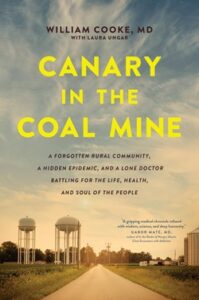 Canary in the Coal Mine: A Forgotten Rural Community, A Hidden Epidemic, and a Lone Doctor Battling for the Life, Health, and Soul of the People William Cooke, MD with Laura Ungar (Tyndale Momentum) $25.99
Canary in the Coal Mine: A Forgotten Rural Community, A Hidden Epidemic, and a Lone Doctor Battling for the Life, Health, and Soul of the People William Cooke, MD with Laura Ungar (Tyndale Momentum) $25.99
OUR SALE PRICE = $20.79
Speaking of heroic doctors working in under-served communities, few books I’ve ever read can rival the aforementioned Soul Full of Coal Dust. However, there is something very compelling about hearing all sorts of stories of those in positions of power and influence who do right, who stand up against stubborn bureaucrats and careless systems, turning tables for the better by staying put, working hard, being agents of change and service. When it is done by people of faith inspired by Biblical principles, it becomes a signpost pointing the way of the Kingdom of God. This recent book, friends, is a quiet testimony, showing how a reformation of small town health care can make a huge difference in the lives of thousands.
Although there is faith (and even an appendix listing “Biblical principles of harm reduction”) this is a story that will appeal to any sort of reader interested in public health and mitigating hurtful social forces — in this case the opioid abuse epidemic and a subsequent, deathly, record-breaking outbreak of HIV and Hep 3 — and how a small town doctor exposed this unseen crisis. Yes, nearly rural Austin, Indiana (situated north of Kentucky, south of Indianapolis) developed the worst case per capita of AIDS in the history of the global disease. As you may guess, this will resonate for those who have read Dopesick by journalist Beth Macy or the brand new The Least of These: True Tales of America and Hope in the Time of Fentanyl and Meth by the powerful writer Sam Quinones (who wrote the much-discussed Dreamland.) Although there is public health information and reporting about the tragedy in Austin, Indiana, it is, truly, a memoir. It is the story of Dr. William Cooke.
As it says on the back cover:
When Dr. Will Cooke, an idealist young physician just out of medical training, set up practice in a small community of Austin, Indiana, he had no idea that much of the town was being torn apart by poverty, addiction, and life-threatening illnesses. Soon, however, he would find himself at the crossroads of two unprecedented health-care disasters: an opioid epidemic and the worst drug-field HIV outbreak ever seen in rural America.
I like that although this is published on an evangelically Christian legacy publishing house, it isn’t primarily one more story of personal piety and learning to trust God or fighting the culture wars, but it is truly a story of public health and hard medical work; this includes battling foes such as the prejudices of politicians, racism, and the seemingly ever-present despair that threatened to overwhelm his own soul.
(And, yes, one of the politicians he has to confront there in Indiana — in a short but revealing scene having to do with a clean needle replacement program widely known to save lives and prevent contagion — is the then-governor Mike Pence who will only say he will “pray about it.” Cooke’s reflections on that are pointed and well worth reading. )
The rave reviews of Canary in the Coal Mine, significantly, are not from the often-seen celebrity authors who usually blurb Christian books, but by other doctors, public health officials, epidemiologists, journalists of note. For instance, Dr. Gabor Maté (who wrote In the Realm of Hungry Ghosts: Close Encounters with Addiction) says:
From the first poignant vignette through many dramatic moments to its inspiringly compassionate conclusion, Dr. William Cooke’s book is a gripping medical chronicle infused with wisdom, science, and deep humanity.
There is a hugely positive review by David Fiellin who directs the addiction program at Yale School of Medicine. There’s a blurb by Jim Curran, the dean of the Rollins School of Public Health at Emory University (and former head of the Division of HIV/AIDS Prevention at the CDC. On and on, there are superlatives from folks from think tanks about rural medicine, public health activists, community development thought leaders. Will Cooke, it should be clear, is a respected doc and hero to many. He has been on nearly every major media outlet (from the New Times and USA Today to NPR to the BBC) and was named the Family Physician of the Year by the Indiana Academy of Family Physicians in 2016.
And Dr. Cooke’s co-author, Laura Ungar, is not a ghost-writer who helped him craft his sentences and write his story; she, too, is a leading thought leader around these very questions. She is a St. Louis-based editor and reporter for Kaiser Health News. She has won more than50 national, regional, and local awards in her years a journalist.
You couldn’t find more authoritative tour guides of rural America than Dr. Cooke and Laura Ungar, who have lived and worked among its people―their people―for decades. The pair’s medical savvy and crackling prose can compete with the best out there… This gripping, heartbreaking, and ultimately hopeful book is about far more than a tiny town and its hardscrabble people, many of whom were affected by one of the biggest HIV outbreaks in US history. It’s a look at where so much of America has been heading when so many others weren’t watching. — Jayne O’Donnell, health policy reporter, USA Today; cofounder, Urban Health Media Project
Kudos to Tyndale for publishing this great story, full of faith and courage and compassion. Now the question: who is going to get the movie rights?
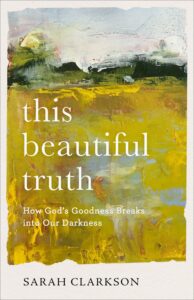 This Beautiful Truth: How God’s Goodness Breaks into our Darkness Sarah Clarkson (Baker) $16.99
This Beautiful Truth: How God’s Goodness Breaks into our Darkness Sarah Clarkson (Baker) $16.99
OUR SALE PRICE = $13.59
You may have seen on my personal Facebook page a video or two from an adult Sunday school class I’ve been helping with, some informal Bible teaching and theological pondering about creativity, the role of the arts in our lives and, more generally, paying attention to the aesthetic dimension of our life in God’s world. In one of them I read out loud a beautiful article (“Embroidering Hope“) by this author (that could have been a part of this book) that had appeared recently in Comment magazine. (It’s a very nice example of her writing style and fits the theme of this wonderful book.) It describes a beautiful tablecloth made by the mother of a friend, a nurse, during a service in the second World War and the joy she experiences seeing it, knowing it. Could this ordinary beauty be healing? A sign of God’s redemption of all things?
This Beautiful Truth is aptly named as it is a beautiful truth, that beauty matters. It is written very much like a memoir, with a few Biblical and theological excursions along the way — she is a solid teacher — and lots of literary explorations. Indeed, characters in Lord of the Rings or Harry Potter or novels by Chesterton make their way into her life and their impact on her are wonderfully described. In a remarkable and eloquent section on home-making she tells of an episode that carries a great truth from Wendell Berry’s Hannah Coulter, which is a foundational work for her. Seriously, doesn’t that speak volumes? (That she cites Browning’s “Aurora Leigh” just seals the deal — who wouldn’t want to read about book that draws on that line about the Earth crammed with heaven, how every common bush is aflame?)
Sarah Clarkson has written several good books, including a fun one about books and the reading life, Book Girl. (As has her mother, her sister, and her brother, Joel, who is exploring similar themes to those in this one, described in Sensing God: Experiencing the Divine in Nature, Food, Music, and Beauty recently released by NavPress.) In This Beautiful Truth Sarah has arranged this narrative nearly as a memoir, sharing discoveries and shaped around her own life, her depression and sorrows, her OCD, her struggles. Her mental health disorders are talked about honestly as are her doubts, and, yes, how notions of beauty (think of the end of Job) can be the reply to the deepest questions of theodicy. She has drawn beauty from so much, from the Book of Kells to Rivendell to Marilyn Robinson’s Lila to personal experiences of charm and loveliness and common grace.
Can God truly be seen and encountered as good? Can the goodness of art and beauty and creativity reveal that to us? Can life lived with verve and sensitivity to beauty be a witness to others as we learn to see ourselves not only as children of (in her wonderful phrase) Lost Eden but also of New Jerusalem? It seemed to have worked that way for her — others and their sharing of beauty or pointing her to wonder, are those very means of grace.
This Beautiful Truth: How God’s Goodness Breaks into our Darkness, unfolds Clarkson’s quest for these kinds of answers, not as mere head knowledge or insights but in what she calls knowings. Like many of us, she yearns for the real experience of goodness and of God. This book is a great read, insightful and wise and persuasive, even; I might say that as enjoyable as it is mature and inviting us to serious reflection without being dense. It is very good to be allowed to share another’s journey and this is a great example of how edifying it can be. There is hard stuff, yes. But there is hope, a hint of restoration, a life unfolded on sacred ground. This very personal book by Sarah Clarkson is one of my favorite Christian books of the year and I very highly recommend it.
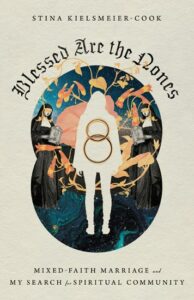 Blessed are the Nones: Mixed-Faith Marriage and My Search for Spiritual Community Stina Kielsmeier-Cook (IVP) $16.00
Blessed are the Nones: Mixed-Faith Marriage and My Search for Spiritual Community Stina Kielsmeier-Cook (IVP) $16.00
OUR SALE PRICE = $12.80
I have been wanting to tell BookNotes readers about this for quite some time, but wasn’t sure how to frame it, when to list it, how to review it. I loved it for several reasons and could see it helping or being enjoyed by any number of different sorts of readers.
It is, in fact, a very helpful book and good resource for anyone going through marriage complexities, especially when the situation is as this book describes — two serious Christians who marry with idealism and hope for a God-glorifying, Kingdom-oriented, holy marriage and come to realize that one of the partners has drifted from faith and no longer believes. How does one cope when the one you love the most doesn’t love what you love most, or, in this case, Who you love most, namely, the Triune God of the Bible?
What if one says they are trying with all their might and the grace they believe they are given by a Spirit they think who guides them, to follow a Jesus who they believe is the King of the world, resurrected from the dead, truly God and truly Friend, and their spouse just doesn’t buy it anymore?
What if the church was a central part of the couple’s life together — the source not only for ritual and meaningful spiritual encounters and music and teaching, but the source of most of their social encounters, their best friends, their support system, and the community in which their very beliefs were underscored and made plausible?
What happens when that union becomes not just a mixed-faith marriage — a Christian and a Jew, say, which is interesting and challenging enough — but the story of a disciple and a none? (As in, you know, those who say they are “none of the above” when asked on a survey what their religion is.)
Yep, this book can help give some good advice about all that since that is what happened when Stina’s husband (and good father to their baby) stopped going to church and finally came clean: he just wasn’t interested in faith any more. She became, as they say, “spiritually single” and, now, wants to help others in this situation (which is more common than many may realize.) So, yep, we put this on the shelf with other books about marriage and its difficulties, about conflict, and next to titles like Lee & Leslie Strobel’s Spiritual Mismatch.
However this is not really a self-improvement resource. It is, truly, a memoir, written exactly as a story with Stina narrating her feelings and experiences as she learned of her husband’s shift to no longer seeing himself as a Christian. She tells of their radically Christian young adult years, their mission trips, their commitments to justice, their experiments with living in intentional community. I so resonated with those few early chapters, feeling the energetic and idealist vision of being young adults sold out to the Kingdom of God and its upside down values. I nearly shuddering hearing her tell of earnest and scary conversations, as we had in those years, reading books about racial injustice and simple lifestyles, freeing resources for those who are poor and for organizations doing the work of social renewal, the call to community and the call to, in the words of Dorothy Day “build a new world in the shell of the old.” Even her description of their eagerness (and struggle) to find a church that helped them with their missional discipleship and their longing for deep and authentic spirituality for the sake of the world sounded so familiar. What a story!
How does that calibre of thoughtful and communal and seriously informed kind of faith come crumbling down? This isn’t the ill-informed faith or watered-down discipleship of nominal believers or flash-in-the-pan religious eccentrics, but the meaningful and visionary stuff of solid Biblical living. But, you can imagine, when one is so deeply committed to Christ’s ways, so fully involved in thinking and living Christianly, when ones very marriage is seen as something akin to a sacrament pointing the way of Christ and His love, when that blows up, well — not to minimize the heartache of it all in their lives — one has a very captivating story to tell. And when one is as fine of a writer as is Kielsmeier-Cook, then one has a very good book to share.
We are so glad for her candor, for her continued love for her husband, for his own willingness to allow his story to be told. Blessed are the Nones is her story, of course, and it is told from her vantage point. But as she says in the acknowledgements, it is a story that he agreed to. It has not been easy (for a variety of reasons) but they remain happily married, as you will find in this great memoir of a changing marriage. As Sarah Bessey writes, it is “a lyrical, honest, moving portrayal of marriage.” I think many will enjoy it.
However, there is yet another thing that makes this thrilling to read, unexpectedly interesting and so, so good. It revolves around this funny play on words, mashing up the journalistic jargon of “nones” (as we have said, those who claim no religious identity) and, yep, nuns. You see, the author, even as she is grieving the loss of a soul-mate and spiritual partner in her marriage, has discovered a group of nuns. And that becomes another big part of the story: Blessed Are the Nones tells of an evangelical woman learning about (single) female saints by hanging out with a group of Salesian nuns in a spiritual formation program in her neighborhood. I’ll be you didn’t see that coming.
This hungering for a deeper contemplative spirituality is evident in the life of Ms. Kielsmeier-Cook. There is a bit early on about what guys like Shane Claiborne and Jonathan Wilson-Hartgrove began to call the “new monastic movement” which shows her awareness of and hunger for some healthy exploration of contemplation and action, the journey inward and outward. As she writes about an episode in her earlier forays into meeting some Catholic folks on retreat she notices a book about Dorothy Day, who, of course, she recognized. It was, as they say, a good sign.
There are wonderful chapters — very well written, but short, almost like stand-alone but inter-related essays — with titles like “Little Virtues” and “Fellow Pilgrims” and “Relinquishment.” Much of this good writing tells of truths learned in her time with these nuns in their Monastic Visitation ministry and her adventure in joining them. She finds new friends, new sisters in these Sisters. And she is introduced more deeply not only to sustained, livable spiritual disciplines and prayer practices but a legacy of female mystics and women saints, most who are — maybe you can see where this is going — unmarried or unhappily married. These women, modern friends down the street and ancient siblings in the great crowd of witnesses, become a support and lifeline for her.
Of course a subtext to all this evangelical and Protestant apprenticing with the Catholic religious women is Stina’s own lack of spiritual fellowship with her husband. To be honest, much of this is just so ecumenically glorious and wonderfully told it would stand alone as a good story of a young evangelical’s Christian growth among those who have commitments in monastic communities. We learn about Francis de Sales and his associate, Saint Jane de Chantel and their intense but deeply holy relationship in the early 1600s. (Jane was, by the way, also a friend of Vincent de Paul, fyi.) And we learn about not only the call to holiness, to a devout life (as de Sales put it) but about community. In one conversation with one of the Sisters Stina describes herself as “spiritually single” and this (obviously unmarried) nun said that the phrase didn’t resonate with her; who among us is truly “single”, after all? Are we all not, in more or less ways, in relationships, in families, part of communities? Naturally, a quote or two from Bonhoeffer’s Life Together crops up soon enough.
And so, again, this is a book about marriage, about mixed-faith marriages, but also very much about a thoughtfully evangelical young adult increasingly learning about spirituality by seeking fellowship and guidance from Catholic sisters. This is such a great read I commend it to everyone.
But, yet, again, it is about her life in this situation. There are vivid scenes of her (and her husband) with their children. There are scenes about getting kids into snowsuits, about Cheerios to keep kids interested in long car trips. There are play dates and church services. There are church services with her husband — he inexplicably attends a Christmas Eve service with the fam — and there are services without him. The wrangling of kids and the tenderly joyful parts of raising children becomes a part of this story as well. Some of it is just lovely.
Blessed Are the Nones: Mixed Faith Marriage and My Search for Spiritual Community is a great read, a well-crafted book, a moving story. It would make a great book club choice, too. Highly recommended.
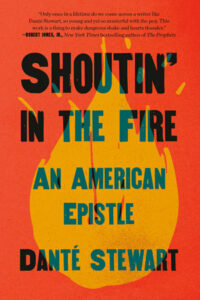 Shoutin’ in the Fire: An American Epistle Danté Stewart (Convergent) $25.00
Shoutin’ in the Fire: An American Epistle Danté Stewart (Convergent) $25.00
OUR SALE PRICE = $20.00
In online conversations and a few Zoom book announcements that I’ve been invited to do for conferences and gatherings, I’ve highlighted this one — it is one of the vital new books of this season. The advanced buzz on it was notable (and believe me, there’s a lot of advanced noise on a lot of books these days!) But when people we know and respect so highly promote a new author, we notice.
For instance, Calvin University scholar and popular historian Kristin Kobes Du Mez says:
“A magnificent debut. . . If you read one book this year, make it this one.”
And listen to this from Zondervan author Jemar Tisby, of The Color of Compromise and How to Fight Racism:
An emotional meditation on race, religion, and nation. In Danté Stewart’s boldly revealing stories of love, pain and renewal, we find our own.
Robert Jones, Jr., himself a New York Times bestselling novelist (author of The Prophets), says
Only once in a lifetime do we come across a writer like Danté Stewart, so young and yet so masterful with the pen. This work is a thing to make dungeons shake and hearts thunder.
The advanced recommendations and rave endorsements kept coming in, from Krista Tippett, Rev. Jacqui Lewis, Imani Perry, Kiese Laymon, Bishop William Barber, Jonathan Wilson-Hartgrove, even the Pittsburgh-based fiction writer Deesha Philyaw. The praise has been shoutin’.
In a way, this book stands among many memoirs naming the complexity of the black experience in white America. Tisby is right — the prose is arresting, the meditations emotional, the insights revealing. One reviewer said Shoutin’ in the Fire is written with “unparalleled candor” which, while perhaps not technically accurate, does illustrate that his is one of the voices in the movement of black authors being real; really real, telling it like it is as we used to say. (This candid truth-telling by black writers is not new, of course, but it does feel particularly frank and fresh, given Stewart’s role within the church and how that is part of his story of “groan and ache.” If you have appreciated the highly-regarded memoir I’m Still Here: Black Dignity in a World Made for Whiteness by Austin Channing Brown (the same publisher, the same shape of trim-sized hardback) Shoutin’ in the Fire should be on your list. It is a book you will find it hard to put down.
I needn’t say much more other than to say that we feel privileged to get to recommend and to sell such important books by black authors of this calibre. Young Mr. Stewart is a very good writer — you can tell from the very first pages — and he is rooted well in a black family in the black community in the black church.
He knows whose shoulders he stands on, too — he cites before each biographical chapter a good epigram, authors like James Baldwin (there’s that fire language, eh?) And bell hooks, Gwendolyn Brooks, Toni Morrison, Audre Lorde, Nikki Giovanni, Ta-Nehisi Coates. And Maya Angelou, of course. And, happily, near the end, rapper Kendrick Lamar. So Danté is a lover of language, nearly a rural poet himself, coming up in Calhoun County, South Carolina. His BA degree was in sociology from Clemson (where he also played football) and he’s currently studying theology at Candler School of Theology in Atlanta. As a writer and speaker, he is one young leader to watch. We all need, as Stewart puts, it in a closing note to Baldwin, “praise breaks and prophetic lines: We shoutin’ in the fire.”
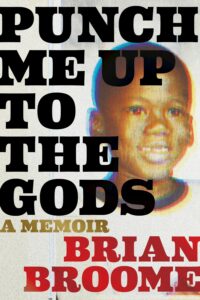 Punch Me Up to the Gods: A Memoir Brian Broome (Houghton Mifflin) $26.00
Punch Me Up to the Gods: A Memoir Brian Broome (Houghton Mifflin) $26.00
OUR SALE PRICE = $20.80
Let me just say it up front: this book is not for everyone. There is graphic sexuality and painful hookups and awful parental abuse and descriptions of drug use that are disturbing. In some ways, much of this book is disturbing. And yet, I was drawn in by the exceptional accolades this debut writer was getting.
For instance, Augusten Burroughs (famous for Running with Scissors) raved like this:
“Punch Me Up to the Gods is some of the finest writing I have ever encountered and one of the most electrifying, powerful, simply spectacular memoirs I — or you — have ever read. And you will read it; you must read it. It contains everything we all crave so deeply: truth, soul, brilliance, grace. It is a masterpiece of a memoir and Brian Broome should win the Pulitzer Prize for writing it. I am in absolute awe and you will be, too.”
Kiese Laymon, whose heavy memoir Heavy I recommended in a BookNotes a few years ago (perhaps with a similar disclaimer), said this:
“Punch Me Up to the Gods obliterates what we thought were the limitations of not just the American memoir, but the possibilities of the American paragraph. I’m not sure a book has ever had me sobbing, punching the air, dying of laughter, and needing to write as much as Brian Broome’s staggering debut.”
Ergo: lover of memoir that I am, minor and small town connoisseur of good writers that I try to be, long interested in black memoirs, I had to pick this up. I’ve often said we should read books by those unlike ourselves and I knew this to be about a queer black man; I felt drawn to understand his life, to want to take in his God-given gifts as writer and storyteller. I had no idea it would effect me so.
First, I’m a sucker for writers from Pittsburgh where we used to live, almost in the years in which his coming of age went down. Mr. Broome is an award winning writer, a poet and screenwriter, and (dig this) he has been a finalist in The Moth storytelling competition He is a Leroy Irvis Fellow and instructor in the writing program at the University of Pittsburgh, where he is pursuing an MFA. He even won the grand prize in Carnegie Mellon University’s Martin Luther King Jr. Writing Awards. He also won a VANN Award from the Pittsburgh Black Media Federation for journalism in 2019. So, he’s a guy whose work we should know. Pittsburgh Yinzer’s — listen up.
And then, on the first page — in a remarkable device that appears throughout the book, with this on-going set of unfolding episodes on an urban bus ride — Broome is getting on his bus in McKeesport, Pennsylvania — exactly where Beth and I lived in the late 70s, in a steel mill town just outside of Pittsburgh. Some of the story is told via these reoccurring scenes as the bus moves by Homestead and towards Squirrel Hill and into Downtown. I have been on that very bus, and it is fascinating for me to read about the experience of a black man with mostly other black riders, a dad and his baby, right there on that Mckeesport line. I was hooked.
After Broome’s father lost his rust-belt job in Ohio he became sullen and brutal and the punishment he doled out on Brian was reprehensible. Broome’s growing awareness of his being gay is interesting, but the horror is in knowing how is father will turn on him. This hard bit of his youth happens mostly in south Eastern Ohio before their move to Pittsburgh and some of these scenes are so striking and the telling so well crafted that they will leave an impression on you, for better or worse. There is a scene in which he goes out dancing with white friends (against his mothers wishes) and is stranded as no white kid would dare ask his parents to give him a lift home. I will never forget that scene. For white readers, especially, like other memoirs by contemporary people of color, this may be surprising (or not) but it is ferocious stuff, powerful on the page, necessary.
I need not chronicle the facts of the downward spiral his lonely life took, visiting dour gay clubs, doing dangerous drugs, the weird sex — one scene struck me as gratuitously vivid — but the whole tragic story is important. And it is not all tragic, either. Dare I say he learns some pride? That God continues to haunt him? I am trying to be generous and discerning about an incredibly well written story with a distinctive voice set in a town I love, but some of this is egregiously graphic. One rave reviewer noted that it “feels like a scream at the end of a summit.”
There is a reason that this book, with the creepy title (a reference to physical abuse) and candor about being queer and black, is getting such lauded reviews and has been so enthusiastically received by some of the black literary world. It is captivating, revealing, well penned. Some of it is that the units of prose themselves are framed by lines from the nameless boys in a famous Gwendolyn Brooks poem (“We Real Cool”) which is itself a stroke of genius. I am not schooled enough or part of that literary community to ascertain much more of the unqualified applause, but with quotes like Laymon’s and rave reviews from poets and novelists and writers likes of Sapphire and R. Eric Thomas and Comonghne Felix, it seems like this is very important. I just know I couldn’t put it down.
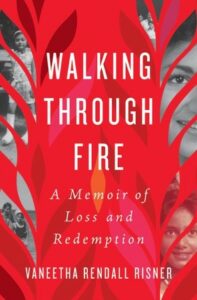 Walking Through the Fire: A Memoir of Loss and Redemption Vaneetha Rendall Risner with a foreword by Ann Voskamp (Nelson Books) $18.99
Walking Through the Fire: A Memoir of Loss and Redemption Vaneetha Rendall Risner with a foreword by Ann Voskamp (Nelson Books) $18.99
OUR SALE PRICE = $15.19
Fire is used as a metaphor in many ways, from various authors, and while this one is not about the black American experience or the soul-wrenching anguish of racism (like Shoutin’ in the Fire, above) it is a burning, burning, painful passion that allows this author to share her story. When Vaneetha Risner’s infant son died due to a doctor’s error, she felt “devoid of purpose, of thought, even of feeling.”
Her anguish is deep and deeply understandably; she reasonably wondered if she hadn’t already suffered enough — she had polio as a child, there were years of being bullied, she learns the heartache of her husbands unfaithfulness, and there were three lost babies due to miscarriage. I think of the line Marva Dawn used to use, quipping that is seems she almost “out Job-ed Job.” Risner has been through a lot, an awful lot.
She does not wallow in her misfortune but she narrates her life in a way that is honest and engaging. Her struggles are real but her faith is inspiring. Her ups and downs are more pronounced than many, but we can still relate to her feeling left out. As a South Asian Indian woman she was treated with prejudice. As a woman with a limp, she was teased as a “cripple.” (A story she recalls in a moment of adult hardship came flooding back to haunt her when a young man said he wouldn’t date her because of her disability.) There really is a lot going on in this story, and there’s plenty to ponder or discuss.
There is a bit of another backstory here as well. In 2005, the CCM singer and recording artist Natalie Grant released the song “Held” that was written about and for Vaneetha when her little one died. She has remained friends with Natalie Grant, who notes,
This book beautifully and honestly tells a story of deep loss and redemption, and it is a must-read for anyone who’s ever wrestled with the question of why a good God would allow such suffering in this world.
Fifteen years later, now, the songwriter of “Held” (Christina Wells) pulled together a group of other women to create more songs as a companion to this book. Included in the book is a QR scan code to download for free More Than Rubies: The Bravest Thing which includes songs by Ellie Holcomb, Jess Ray, Nicole Witt and Taylor Leonhardt. Not a bad bonus, eh?
As they say in the back of the book,
These five songs, written during the global pandemic, speak poignantly to the themes of Vaneetha’s particular story, which includes suffering, compassion, repentance, forgiveness and courage, while also hitting the heart of our struggle to thrive in the midst of great fear and uncertainty.
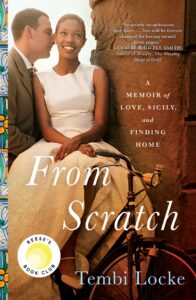 From Scratch: A Memoir of Love, Sicily, and Finding Home Tembi Locke (Simon & Schuster) $17.00
From Scratch: A Memoir of Love, Sicily, and Finding Home Tembi Locke (Simon & Schuster) $17.00
OUR SALE PRICE = $13.60
I know in the above BookNotes reviews (and many of the previous ones from last week’s post) most of the memoirs are rather heavy, dramatically telling of personal anguish or social injustice or coping with the pathos of complicated lives. We believe these are, in a way, entertaining, compelling, and well worth reading.
Sometimes, though, we read memoirs for the joy of the language, the telling of a nice story, even one that invites us into the pleasures of an interesting life in a good world. This is the case, mostly, at least, with this recent love story — a poignant, cross-cultural one, I might add — that is both let against a lush background and is lushly written. Tubi Locke (a TV and film actress and TEDx speaker) is elegant and eloquent. And her story is set in the Sicilian countryside. What caught my attention (besides the admittedly alluring cover photo) was the publisher’s promise that the author “discovers the healing powers of food and family.”
From Scratch chronicles three summers in which Tembi spends in the Italian countryside with her daughter and in-laws. There are shades of those other famous books about the gifts of simple, fresh food, the embrace of a close-knit community, and (as the back cover puts it) “the wisdom that lights a path forward.” But there is more; yes, more pathos.
I guess I need to say this — spoiler alert —it is also a story of grief, recovering as she does, from the death of her beloved husband. The very first sentence is striking: “In Sicilian, every story begins with a marriage or death. In my case, it’s both.” There is a now-almost-famous section in which she compares cheese-making to grief and it is quite moving and profound. (Both need “time, labor, and attention”, she reminds us.)
From Scratch is a gorgeously written book, what one reviewer describes as “an utterly incandescent love story.” Words like luminous and lyrical come to mind. It’s a lovely memoir, a story about an experience in life most of us will not have, at least not in the particulars of these European visits.
This was a Reese Witherspoon Book Club selection, and I see why. As Reese herself puts it, “This book gives me all the feels.”
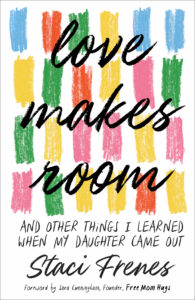 Love Makes Room And Other Things I Learned When My Daughter Came Out Staci Frenes (Broadleaf Books) $18.99
Love Makes Room And Other Things I Learned When My Daughter Came Out Staci Frenes (Broadleaf Books) $18.99
OUR SALE PRICE = $15.19
Speaking of “all the feels”, Love Makes Room And Other Things I Learned… sure did that for me. It may not for you for any number of reasons, but I have been reading over the last years numerous memoirs of LGTBQ persons, often stories of being exiled from church, sometimes memoirs of being terribly mistreated, sometimes even by parents. This touching memoir, by a evangelical worship leader mom whose daughter came out amidst a flurry of tears in her senior year of high school, is one we highly recommend for those wanting to see how a family “copes” and learns to walk through the various feelings and convictions and attitudes they encounter in this situation.
And, yep, they encounter all sorts of stuff from their own heart issues, their own theological beliefs, their own prejudices and presumptions about what it all might look like as their daughter goes off to college and identifies as a Christian lesbian.
And it was anguishing for them as parents — there are obvious questions about Biblical interpretation and theological formulations that concerned them, but there were more emotional sorts of fears, too. There is a tear-jerking episode of mom Staci thinking about her beautiful wedding dress and how she had so hoped to bequeath it to her daughter, Abby. Will that not, now, be possible? The scene seemed emblematic of so much. And there were questions for her and her husband and daughter about extended family members and church friends and, well, (let’s be honest) Frenes is an evangelical worship leader and recording artist of praise songs and this isn’t part of their vision for their lives, their witness to the world, their sub-culture. Her reputation and career are on the line. You can imagine.
And yet, as the title suggests, love is the “greatest of these” and their familial love and their love of God and the love of God for them sustained them in a way that allowed them not to have to write the book that others have written about family dysfunction and ugliness and hurt and judgement. In another heartbreaking book by a gay daughter of a chief spokesperson for Focus on the Family, of all people, turned his back on his daughter. Such outright rejection is not uncommon, especially from church folks, and those who know gay, lesbian or trans kids know the hurt so many carry, that their friends and lovers have carried, about being banned from their family, there parents, their siblings, their home church. How such cruelty can be seen as acceptable in the body of Christ is beyond me.
As complicated as it may have been (and, to be honest, I was a bit annoyed by the author’s wrought, first thoughts about all of this) the eventual transforming grace in the life of the Frenes family allowed them to show empathy and care and eventual acceptance of their daughter.
You can read the ups and down of how it all happened and how this may serve as a model for other evangelical folks who want to be faithful and affirming or at least accepting. As one reviewer puts it, “This is a story of invitation and awakening.”
Jonathan Merritt, author most recently of Learning to Speak God from Scratch, writes about Love Makes Room:
If you are committed to understanding and loving your gay child, queer cousin, or trans neighbor, start with Love Makes Room. The story of Staci Frenes’ quest for a more expansive expression of love will help you make room in your heart for others too. It’s that simple. It’s that difficult. It’s that profound.
Of course, you may not agree with her choices or strategies of how to show love, or of what God’s grace looks like in families like this. I don’t list this here as a guidebook or manual or theological study as it is not. It’s a memoir. It’s a story, a love story. It’s one testimonial of how one family walked through some things that were hard and surprising for them. It’s a good read.
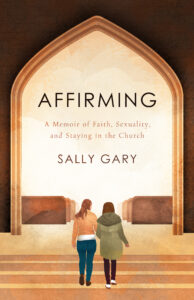 Affirming: A Memoir of Faith, Sexuality and Staying in the Church Sally Gary (Eerdmans) $19.99
Affirming: A Memoir of Faith, Sexuality and Staying in the Church Sally Gary (Eerdmans) $19.99
OUR SALE PRICE = $15.99
I mentioned above that I have been reading — for years, now, actually — books of stories of families experiencing (for some “coping” is a word they’d use, “navigating” or “accepting” may be how others put it) a family member coming out as gay or lesbian or trans. Each story, of course, like each person and each family, is different. Some are fairly upbeat and generous, others are horrific, explaining toxic rejection that borders on abuse. None are particularly detailed about Bible or theological puzzlements on this contested topic (what the Bible means to say about same-sex attraction and marriage) because, again, in this genre, at least, we are talking about stories.
Memoirs often read like novels, not so much mere autobiographical data, but sharing the memories of the interior life of the author as he or she moves through life. When there are huge identity crisis’s or worldview upheavals or social conflict, it is often anguishing but makes for instructive reading. Learning how others experience and make sense of and construe their lives, how they bear witness (and to what) is helpful and often inspiring. Agree with the author or not (heck, like the author or not) this is why we encourage folks to read memoir — to grow wiser (and hopefully more empathetic) about the human condition, at least.
(And yet, some are so poorly written they seem hardly worth the time; others are so tendentious or lacking in nuance that they seem like propaganda. And, occasionally, there are some that are so amoral or advocating such unhealthy attitudes that one fears they might somehow be harmful. I recently purchased a memoir of a religious woman breaking free from her previously toxic and shameful view of human sexuality and, fiesty and fun as she seemed to be, her advocacy (and graphic narration of) open sexual expression was so unwise I just couldn’t promote it, even as a memoir. So there’s that.)
I say all that to say that there are those among our readership who ought to read this recent Sally Gary memoir (her second) even if they are likely to disapprove. It is a very good story, well-written, honest, and thoughtful as she describes her journey within a conservative Christian denomination and Southern subculture of coming out and embracing her role as a woman of God who is affirming of her own same sex attractions. It is also a story of her own grappling with her previous views of all this, a story of changing one’s mind.
Affirming is a powerfully written memoir and strikingly wholesome story that I couldn’t put it down. To be honest, I shed tears of joy to hear a pro-gay advocate who has a relatively decent relationship with her older, conservative parents, her conventional Bible church, keeping her self-proclaimed identity as an evangelical. With so much deconstruction and drifting away from core evangelical truths these days — and a valorization of that, it seems, in some circles — it was refreshing to see a woman reforming her theological views on this one thing without ditching the whole of evangelical faith and robust Christian discipleship and her love of the Bible.
As Don McLaughlin (a senior minister of the North Atlantic Church of Christ who, I suspect, does not fully agree with Sally’s position as a fully affirming Christian) puts it,
I have known Sally Gary for nearly twenty years. She has been — and still is — deeply committed to faith, Scripture, and the church. In sync with the same spirit she has demonstrated all these years, I recommend this vital work. Sally does not demand agreement, but she appeals for understanding — for a hearing of her personal journey as a gay Christ-follower and as a member of his body, the church.
Here is part of the backstory of this moving story: a decade ago Sally came out as a gay, Southern Christian and, perhaps inspired by Wesley Hill’s Washed and Waiting: Reflections on Christian Faithfulness and Homosexuality, she wrote a book called Loves God, Likes Girls: A Memoir, published by her denominational publishing house, Leafwood. She tells of her Churches of Christ church culture, of Texas youth groups and holiness church camps, of mission trips and the young adult Christian college scene at Abilene Christian University, and other telling bits about her life and Bible believing family within her tightly knit church (and denomination.) It was moving to learn what it was like coming out even as she assured readers that she still believed in the conventional Biblical interpretation that these desires were disordered and that she would be committed to Christian celibacy.
(As you may know, there is quite a movement, these days of LGBTQ believers who feel it is best to be out and generally unashamed about their sexuality but who still maintain traditionalist views of sexual ethics and marriage. See, for instance, the recent book of stories compiled by Mark Yarhouse and Olya Zaporozherts called Costly Obedience: What We Can Learn from the Celibate Gay Christian Community.)
As should be clear from the new title of this new one by Ms Gary, her second memoir (published by Eerdmans) is about her growth and change, about her changing her mind about what the Bible does and doesn’t say and mean and demand, and how to share that more inclusive and affirming view with her people. Affirming is no screed or Bible study (although, in memoir fashion, she does describe some of the process and conversations she went through in this conversion to this new perspective.) I resonated with listening in as a vibrant and thoughtful young woman who obviously loves Jesus and her family and her church undertook a journey to figure something out, to study and pray and read and talk and listen to others from various quarters, all while trying to be honest about her experiences, her understanding, her soul and her loves, and what it means to be faithful to the God she knows.
After college, Sally was working in Christian higher education, got a Master’s Degree from Abilene Christian and spent some time as a person of evangelical faith earning a law degree from Texas Tech. (Did I say she is super smart?) Soon enough, she started a safe place called CenterPeace that has become known as a helpful nonprofit to minister to and with LGBTQ and questioning kids. As she becomes clearer about her own need for personal integrity and as she is honest about her desires (unchanged after years of celibacy and prayer and advocacy for trusting God in traditionalist views) she increasingly saw her lesbian sexuality less in conflict with her faith but as a given from God, an orientation that called forth certain kinds of intimacies. As the publisher puts it, “Her story is a resounding reminder that, just like Sally’s own heart, things can chance, and, sometimes, when we earnestly search for the truth, we find it in the most unexpected places.”
I appreciate and affirm the comments about Affirming: A Memoir… by Justin Lee (author of Torn: Rescuing the Gospel from the Gays vs Christians Debate) who says:
This is a powerful read — not only for Christians who want to better understand the LGBTQ community, but for anyone wanting to rekindle their faith. A few chapters in, I thought I was reading a simple, folksy memoir of growing up in the Churches of Christ. By the end, I had tears in my eyes. In a world that increasingly sees Christians as hypocrites and homophobes, Sally’s story is just what we need to remind us of what drew so many of us to Jesus in the first place.
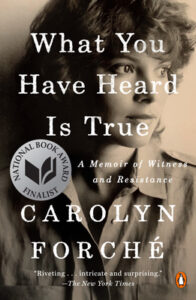 What You Have Heard Is True: A Memoir of Witness and Resistance Carolyn Forché (Penguin) $18.00
What You Have Heard Is True: A Memoir of Witness and Resistance Carolyn Forché (Penguin) $18.00
OUR SALE PRICE = $14.40
Do you recall I said in both the previous BookNotes listing of memoirs (“Part One”) and at the start of this column (“Part Two”), that I’ve recently read books that are utterly unforgettable for me? This is one of those, a story that kept me up late at night, tearing through the pages, only to stop and tell anybody within listening distance how weird and exciting and powerful and captivating this wrenching, brutal, spectacular story is. It is hard to explain and I will not do it just in my brief description. I don’t think I’ve ever read anything quite like it. Wow.
First, I am not alone in raving about this riveting read. It was a Finalist for the National Book Award in 2019. Margaret Atwood called it “astonishing” and one paper’s review said it was “Unflinching… Reading it will change you, perhaps forever.” The New York Times called it “Riveting, intricate and surprising.” The New York Times Book Review said:
One recovered incident, person, landscape, and image at a time, the narrative advances, accruing tremendous authority and emotional power… it is a magnificent memoir.
What is it about? It is a rememberance of a period in the life of poet Carolyn Forche who was twenty-seven when a mysterious stranger first appears on her doorstep. She is a working writer, teacher, in a relationship, socially conscious but comfortable in her bohemian artsy lifestyle.
After a stunning foreword, the first line of the first chapter is “Over the years, I have asked myself what would have happened if I hadn’t answered the door that morning, if I’d hidden until the stranger was gone.”
I can hardly explain to you why you should consider this extraordinary book; should I start with the quality of the luminous writing, the reputation she has garnered as a poet (and now as a memoirist) in league with Pablo Neruda or Czelslaw Milosz for giving us an account, in the words of one critic, “of a poet’s education, the struggle of a great artist to be worthy of her gifts.”
Or, perhaps somewhat easier — although it is so bizarre it is hard to say it convincingly — I should tell you what the basic plot is. You see, this stranger seems like a character from a TV show or movie— larger than life, obsessed, mystifying, utterly compelling, at least to follow and see what the hell is going on. He invites her to go to El Salvador with him and she agrees.
As the back cover explains:
Carolyn Forché is twenty-seven when the mysterious stranger appears on her doorstep. The relative of a friend, he is a charming polymath with a mind as seemingly disordered as it is brilliant. She’s heard rumors from her friend about who he might be: a lone wolf, a communist, a CIA operative, a sharpshooter, a revolutionary, a small coffee farmer, but according to her, no one seemed to know for certain. He has driven from El Salvador to invite Forché to visit and learn about his country. Captivated for reasons she doesn’t fully understand, she accepts and becomes enmeshed in something beyond her comprehension.
Together they meet with high-ranking military officers, impoverished farm workers, and clergy desperately trying to assist the poor and keep the peace. These encounters are a part of his plan to educate her, but also to learn for himself just how close the country is to war. As priests and farm-workers are murdered and protest marches attacked, he is determined to save his country, and Forché is swept up in his work and in the lives of his friends. Pursued by death squads and sheltering in safe houses, the two forge a rich friendship, as she attempts to make sense of what she’s experiencing and establish a moral foothold amidst profound suffering. This is the powerful story of a poet’s experience in a country on the verge of war, and a journey toward social conscience in a perilous time.
So. There are the bare bones of this enchanting, spellbinding, powerful story. For those of us who protested the awful actions of the US government (in the Reagan years, mostly) of supporting death squares, the School of the Americas teaching assassination, of rape and torture, the killing of nuns and the hit-squad murder of Archbishop Oscar Romero, picking up this literary memoir and reading up close about farmworkers and peasant collectives, about murder and CIA involvement, about the repression of the churches who wanted to help their poor parishioners find the bodies of the disappeared, this is a bad trip down a rocky memory lane. For those who do not know about, say, how on Dec. 2, 1980, three US missionary nuns (Ita Ford, Maura Clarke, and Dorothy Kazel) and a lay missioner (Jean Donovan) were captured, raped, and murdered by members of the U.S. backed El Salvador National Guard and how their religious reputations were so besmirched by White House spokespersons, well, this is a story diving into that place in those years.
Yet, the unusual character who befriended Forché —Leonel Gomes Vides — is as interesting and colorful and hopeful as any fictional character I can recall. We are left wondering how he came to know so many people in so many places of so many political parties and sympathies (in countries other than his own, even)? How did he come to care? He is magnetic and insistent. No wonder she follows him to the isthmus of central America. No wonder she stays longer than she intended. No wonder her mind is captivated and her heart broken over the tragedies unfolding. This is much of the point, he says — he wants her to be a good poet, a good artist, and to tell the truth about the impending doom. Why her? She wonders that until this day…
What You Have Heard Is True: A Memoir of Witness and Resistance is an important book and a heck of a ride. It is mesmerizing and curious, odd and prophetic. I hope a few of our BookNotes readers order it from us. As I said, I don’t think I’ve ever read anything like it.
Don’t miss these endorsements. Please, really — read these recommendations.
“Carolyn Forché asks us not only to hear, but to see, the scale of human and moral devastation in El Salvador. For those of us who are citizens and residents of the United States, Forché’s powerful, moving, and disturbing memoir also demands that we recognize our country’s responsibility for the atrocities committed by the El Salvadoran military. As is the case with her poetry, Forché’s nonfiction asserts the need for truth–in our politics, in our writing, in our witnessing.” — Viet Thanh Nguyen, author of The Sympathizer
“In this galvanizing memoir, Forché recounts her political awakening under fire with a poet’s lyrical acuity and a storyteller’s drama…. Forché recounts her frightening and transformative encounters with scorching specificity and portrays her brilliant and courageous mentor and other resistance fighters with wonder and gratitude. This clarion work of remembrance, this indelible testimony to a horrific battle in the unending struggle for human rights, justice, and peace, stands with the dispatches of Isabel Allende, Eduardo Galeano, Pablo Neruda, and Elena Poniatowska.” — Booklist, starred review
“In this searing, vital memoir, Carolyn Forché at last reveals the dark stories behind her famous early poems: she brings alive the brutality, complexity and idealism of El Salvador in the late 1970s, a time of revolution that echoes all too painfully in the present. What You Have Heard Is True, a riveting and essential account of a young woman’s political and human awakening, is as beautiful as it is painful to read.” —Claire Messud, author of The Burning Girl
“What You Have Heard Is True is as much an enthralling account of a life marked by an encounter as it is a document of a time and place. Carolyn Forche’s urgent and compelling memoir narrates her role as witness in an especially explosive and precarious period in El Salvador’s history. This incredible book shapes chaos into accountability. It marries the attentive sensibility of a master poet with the unflinching eyes of a human rights activist.” — Claudia Rankine, author of Citizen
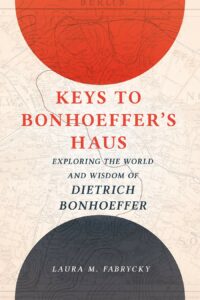 Keys to Bonhoeffer’s Haus: Exploring the World and Wisdom of Dietrich Bonhoeffer Laura M. Fabrycky (Fortress Press) $25.99
Keys to Bonhoeffer’s Haus: Exploring the World and Wisdom of Dietrich Bonhoeffer Laura M. Fabrycky (Fortress Press) $25.99
OUR SALE PRICE = $20.79
One of the frustrations of the hard hit of the pandemic over the last year was that we were unable to do our annual Best Books of the Year awards, our often two or three part BookNotes that celebrate our favorite books each year. Had we had the ability to get that done last year, this book — which came out in Lent of 2020 — would have been on it. As that Spring turned to Summer and Fall, we didn’t, almost a year ago, create that big list, and like many author’s that season, their books perhaps didn’t get the hearing they deserved.
We raved about this the best we could we it first came out. I have visited and revisited this and I continue to think it is not only an impressive work but an important one. Not only because it revolves around the life of Bonhoeffer (always an interesting and edifying topic) but because it shines as a memoir. It is, actually, the story of Laura’s work as a volunteer at the museum housed in the old Bonhoeffer house in Berlin. In a very real sense, this is a story of discovery, a memoir about learning and, importantly, with what one does with what one learns.
Near the end, in a chapter called “Befriending Bonhoeffer” she tells about how Eberhard Bethge, Bonhoeffer’s comrade in the Confessing Church movement, colleague in daily work and dear friend later initiated the project (in 1983) “to make the house place of memorial of Bonhoeffer’s life and legacy and for others to encounter his life too.” She tells a fascinating side story of an arts and writing group she is in (it’s a memoir, after all, or nearly so) and then brings it together recalling not only Bonhoeffer’s Life Together, but his deep friendships. “The Bonhoeffer-Haus reminds me,” Fabrycky continues:
…that relationships are central to the business of our common good, our common lives. A home is one of the small and seemingly insignificant places where trust is built hour by hour, day by day, while attending to household tasks… a house is a place where friendships can be discovered, sustained, and even rekindled. Our friendships need places, too.
This good insight about place comes on the heels of another discussion about embodied life in the digital age — again, you can see that she is learning from the attention payed to the details in this place, this historic, German haus.
When I reviewed it in a March 2020 BookNotes, I said, “It is timely, beautiful, informative, and exceptionally profound. I loved it.”
Here is more of what I wrote in that review:
Keys to… isn’t precisely a biography, as it is a memoir of an (American) woman who became a curator at the home – the haus – of Bonhoeffer in Berlin. It is a look into his world by way of being in his neighborhood and, literally, his house. In a way, this is an ideal window into the man and his role in history for those that don’t want to wade through a major, chronological biography.
Beautiful? Oh my, I should describe this with vivid and glowing words but cannot do this lovely book justice. Laura Fabrycky is a very fine writer and has given us a book that is intelligent and eloquent and elegant and creative. That she is, in fact, a published poet doesn’t hurt. (See her Give Me the Word: Advent and Other Poems.) Those of us who enjoy memoir and creative nonfiction will enjoy these essays that are grounded in her own story, living in Berlin with her diplomat husband and young children, discovering this nearby house, being drawn to it time and time again, eventually learning to be a guide to the tours. We are enthralled as she increasingly feels at home reflecting on the story that is mid-twentieth century Germany, the complicity of the Church with Nazism, and the faithfulness of the underground Confessing Church movement.
We learn much about the fidelity of this movement and this particular man who lived in the haus, but it is also the story of Laura’s learning, Laura’s own internalizing of the issues that pressed upon them in those hard years and what it may mean for our own faithfulness in our time, in any time. This makes for reflective writing and she is self-aware and artful in how she shares her story. It makes Keys to Bonhoeffer’s Haus a truly enjoyable and very stimulating reading experience.
I said it was informative. It certainly is because although it is a first-person narrative of the Fabrycky family in foreign service in Germany and Laura’s own coming to grips with what she was learning, she does share, in fact, what she was learning. So it is very informative about good stuff – documents that she discovers, paintings, books, and a very clear report of her own study of the history of German culture – and it is informative about little things. For instance, there is a cigarette burn on the famous desk of Bonhoeffer in his small bedroom. There is a clavichord there in the corner. (We know how much he loved music and many of us will recall that he commends singing as a body in his classic book Life Together.) She doesn’t just teach us that Bonhoeffer studied and valued music, she write about the clavichord. You really do learn a lot from this book, in fresh and compelling ways, even if you’ve read Bonhoeffer’s own books and the standard bios about him.
Keys To Bonhoeffer’s Haus: Exploring the World and Wisdom of Dietrich Bonhoeffer is, as I have said, timely, beautiful, and very informative. But it is the fourth trait that I mentioned – its profundity – that deserves critical conversation and I wish I had room to explore it more: the book is profound and wise and good as the author helps us learn to understand our own complicity in injustices and how we are implicated in the fallenness of our times; further, she deeply knows of the grace of the gospel which not only forgives but calls us all to take up – as her friend Steve Garber puts it – “visions of vocation” as we “weave together belief and behavior.” Or, as Bonhoeffer put it more tersely, as we die to self by taking up “the cost of discipleship.”
The book has been called “part biography, part travel memoir, and part call to action” and it is Fabrycky’s gentle, yet morally serious “call to action” that must be considered. She does not preach or cajole; she is not ideological, left or right. (I simply most note that, as Stephen Haynes explores in his book The Battle for Bonhoeffer: Debating Discipleship in the Age of Trump [Eerdmans; $19.99] many Bonhoeffer scholars and fans and biographers are themselves deeply committed to right wing or left wing assumptions and ideologies.)
Ms. Fabrycky is not unbiased, of course (no one is) and she is interested in our civic responsibilities and our public witness, but not merely around this cause or that issue. It is rare, I think, in the way in which the author invites us to allow Bonhoeffer to inform us, to speak to us anew, but profoundly and radically, which is part of the value of this extraordinary book. Her moral imagination has been shaped by other important writers and thinkers, again, making this a book from which you will learn much and be called to much. (What do we do with what we know she asks – especially in an unforgettable reflection on the skilled engineers who improved the efficiencies of the death camps and, of course, her reminder of the famous line by Arendt about the banality of evil.) She knows a bit about our own troubled times and she knows some of what we might discover when we study the details of Bonhoeffer’s life. That is, to put it rather simplistically, this book helps us learn what we do today to be faithful to Bonhoeffer’s legacy. How might we be responsible in our own time in history as he was in his?
As Dr. Victorian Barnett (the general editor of the esteemed Bonhoeffer Works English translation project puts it) Laura Fabrycky “offers a profound and moving reflection on what history can teach us about living mindfully and faithfully.”
I like very much the way Anne Snyder, editor of Comment magazine, describes Keys to Bonhoeffer’s Haus:
With self-awareness, vulnerability, humility, and historical rigor, Fabrycky captains a journey that is as engrossing as it is instructive. While Bonhoeffer’s times are not our times, there are echoes worth attending to: his keys to a discernment of public consequence, our keys to private sanity and civic hope.
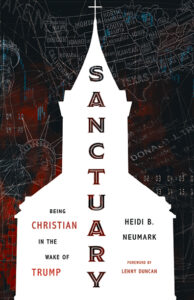 Sanctuary: Being a Christian in the Wake of Trump Heidi B. Neumark (Eerdmans) $24.99
Sanctuary: Being a Christian in the Wake of Trump Heidi B. Neumark (Eerdmans) $24.99
OUR SALE PRICE = $19.99
There is quite a collection these days of well written memoirs of pastors within mainline denominational churches. If evangelicals are telling stories of personal faith (and, increasingly, deconstruction of childhood verities and church cultures) or how God has helped them though various and sundry difficulties, how to live ones best life now, mainline folks continue to struggle with what it means to be a progressive voice in an increasingly conservative US culture, shaped by the ethics of Jesus and the passion of the prophetic who denounced injustice, greed, and the like. For those captured by the liberationist themes of the gospel, insisting that faith must embody Jubilee-justice and be “good news to the poor” (as Jesus himself put it in his first sermon, recorded in Luke 4) the ways in which ordinary churches do that is vexing at best. From clergy burnout to wholistic evangelism, from caring for ones unchurched neighbors to being prophetic in matters of racial injustice, we have many books narrating the lives of pastors and clergy within conventional mainline parishes.
Such is the incredible witness of Heidi Neumark, who has served (and written about) being a Lutheran pastor in the South Bronx and, now, in Manhattan. One need not necessarily see this as a call to faith-based resistance to the policies and demeanor of the President during the Trump years (although that is when the book was written) but, rather, as a story of a congregation’s vision to create real community in the face of urban poverty, homelessness, gentrification issues, racism, repression of immigrants, drug and health problems, etcetera. The cultural pressure against helping immigrants and the poor was heating up. Few pastors have the capacity to lead churches that care about so many of these pressing issues, but there she is, thick in the middle of a very personal ministry among (as her friend Liz Theoharis of the Poor People’s Campaign puts it) “the bruised, battered, and abandoned.” She continues, “Neumark’s stories embody the call of the gospel to preach good news to the poor and bring comfort to the broken amid bedbugs, detention centers, and systemic injustice.”
Rev. Neumark’s first book was an eloquent read, published nicely on a mainstream publishing house, entitled Breathing Space: A Spiritual Journey in the South Bronx. The title of this, her recent memoir, Sanctuary, seems to be a bit of a bridge from and connected to, that earlier phrase “Breathing Space.” As she puts it early on in the book, “Through the pages of this book, I invite you into various spaces of sanctuary — not as places of retreat, but for the deepened resistance, vision, and transformation that these days and the gospel require.” She offers a gospel that can be a sanctuary amid the turmoils of life and in this book she pushes that to be a more public sort of space, as “the true Christian calling is to live out a counterpoint to today’s prevailing spirits of exclusion and hatred.
She uses her own bilingual and multicultural congregation (Holy Trinity Lutheran) as somewhat of a model of trying to live this way, do church this way, walking us through the liturgical seasons of the church year as stories of inclusive and caring ministry unfold. There are vivid church stories here, bringing to mind the testimony in books like the fabulous For All Who Hunger: Searching for Communion in a Shattered World by Emily Scott or Jesus Freak: Feeding, Healing, Raising the Dead by Sara Miles or Accidental Saints by Nadia Bolz-Weber or the work of Jehu’s Table in Brooklyn, pastored by Lenny Duncan (author of Dear Church, shaped by his life described in United States of Grace: A Memoir of Homelessness, Addiction, Incarceration, and Hope.)
“Heidi Neumark’s books always take me to places I’ve never been. Sanctuary is no exception. It is more than a prophetic response to one president or one political party. It is a series of eloquent dispatches from the front where genuine ministry is happening, delivered by a trusted and wise messenger. This is a wonderful book.” — Richard Lischer, author of Just Tell the Truth: A Call to Faith, Hope, and Courage
“Neumark has the unique ability to bring together people and events that are seldom in the same space—consider her chapter, ‘Bed Bugs, Condoms, Frankincense, and Myrrh.’ Biblical texts and church seasons intersect with politics without apology: ‘It’s remarkable,’ she writes, ‘that people who gather to worship in spaces with a cross prominently displayed become upset about politics in the sanctuary.’ You will never say ‘sanctuary’ again without hearing her passionate plea for the church to take sides—based on the Bible—with those whose lives are demeaned and dismissed. This is a book many have been waiting for; hopefully, it will also be read by those who didn’t know they were waiting.” — Barbara K. Lundblad Union Theological Seminary, New York City
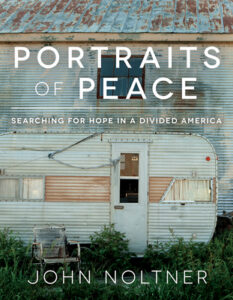 Portraits of Peace: Searching for Hope in a Divided America John Noltner (Broadleaf Books) $27.99
Portraits of Peace: Searching for Hope in a Divided America John Noltner (Broadleaf Books) $27.99
OUR SALE PRICE = $22.39
When a handsome book of black and white portraits appears with the suggesting shelving categories as “travel and travelogue” and “photography” and “memoir”, but it is done by a respected peacemaker, we are not exactly sure what to do with it. As with many good books, this new one defies easy categorization. It is a slightly oversized hardback with artful photographs of people — not the zestfully playful “Humans of New York” project (cool as that is) but moody close-ups that capture the eyes, the clothing, the place, perhaps, of people across our land. Evocative and helpful as they are, this is not primarily a book of photographs, but it is about the photographs, about the people and their hopes and dreams.
The author is a master of the portrait, but his deeper agenda is to get to know people across social and cultural and political divides. This really is a story about hearing people’s stories and their longing for safety and respect and well being. Although the authors good photographs have appeared in distinguished publications such as National Geographic and Forbes and Midwest Living, he is also a born storyteller. This book is the prefect combination of his art of photography, his art of listening well, and his art of storytelling as he takes us on the journey across American to get these shots and hear these folks. And, always, he asks one key question.
In fact, here is how the publisher describes this publishing project:
Frustrated with an increasingly polarized social landscape, award-winning photographer John Noltner set out on a 40,000-mile road trip across the United States to rediscover the common humanity that connects us. He did so by asking people one simple question: What does peace mean to you? Through difficult conversations, gentle humor, and a keen eye for beauty, Noltner’s Portraits of Peace captures a rich collage of who we are as a nation.
In a sense, Portraits of Peace is a perfect book to end our list of good memoirs. It is a tribute to hearing well the stories of others and honoring the dignity of all. Yes, he is searching for hope in this increasingly divided culture (and, yes, even this stance of wanting to hear others and be a peacemaker is, itself, a divisive thing to some.) Still, on he goes, asking about peace. Some of his work has been on tour with the Nobel Peace Prize Forum, the National Civil Rights Museum, and the intriguing Gandhi-King Conference on Nonviolence and now Portraits of Peace is yet another resource for peace building, right here at home.
Perhaps this book can be a “promising road map to a peaceful future as a pluralistic society.”
Listen to what two great peacemakers — Parker Palmer and Padraig O Team — have said about this handsome volume:
Getting to know each other’s personal stories is one of the best ways to bridge our deep divides and reclaim the power of ‘We the People’; this book gives us that chance. Portraits of Peace also gives us a chance to correct the lenses through which we look at others, and get back in touch with our shared humanity. — Parker J. Palmer, author of Healing the Heart of Democracy, Let Your Life Speak, and On the Brink of Everything
John Noltner knows three things about stories: people have them; people need to be heard; people need to listen. In this latest collection of stories, he comforts and challenges, he shows the fractured stories and the flourishing ones, he shares stories that contract and stories that expand. In this, he is a curator of the thing that might save us: our capacity to tell; our capacity to listen; our capacity to change. — Pádraig Ó Tuama, host of Poetry Unbound, and author of In the Shelter and Borders and Belonging
 PRE-ORDER NOW Fortune: How Race Broke My Family and The World and How to Repair It All Lisa Sharon Harper (Brazos Press) $24.99
PRE-ORDER NOW Fortune: How Race Broke My Family and The World and How to Repair It All Lisa Sharon Harper (Brazos Press) $24.99
OUR SALE PRICE = $19.99 Not Yet Released : DUE FEBRUARY 8, 2022
This author is a friend that we esteem so much –she is brave and outspoken and an amazing leader with a robust and holistic vision of the reign of God and how the reconciliation Christ brings is the only answer to our world’s messed up condition. In her must-read The Very Good Gospel she unpacks the Bible’s narrative as she moves from the goodness of creational shalom to the way sin and idolatry has caused alienation and brokenness and how Christ comes to make things new, to healed, restore, reconcile. In the second half of that book she shows how a stronger vision and commitment to the ministry of reconciliation could impact various arenas of alienation — between genders, nations, the rich and the poor, races, humans and other creatures, even ourselves and our own bodies. Our ultimate alienation from God is the fundamental problem and flowing out from the gracious mercy of God that heals that wound, other wounds can be healed. She is one of the most realistic people I know about the horrible implications of personal and institutional and cultural sin and yet, as a Biblical Christian, she remains hopeful somehow.
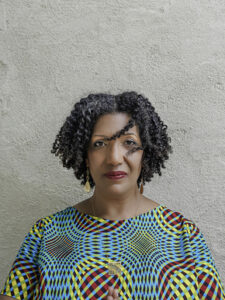 Those who have heard her speak or read her books know that in her ancestry there are, of course, enslaved persons. And indigenous First Nation peoples. She carries in her own genes the results of oppression and anguish and courage and resistance (and, she has connected with others of her multi-ethnic background and, this, and be fruitful with some humane and glorious stories. This, too, is a sign of Kingdom come.)
Those who have heard her speak or read her books know that in her ancestry there are, of course, enslaved persons. And indigenous First Nation peoples. She carries in her own genes the results of oppression and anguish and courage and resistance (and, she has connected with others of her multi-ethnic background and, this, and be fruitful with some humane and glorious stories. This, too, is a sign of Kingdom come.)
That Lisa has taken up the significant calling of writing down her ancestry and her family story, is heavy and exceptional. Fortune is now one of our most anticipated releases of the forthcoming New Year with both Beth and me very eager to see this book. Lisa has been working on this genealogical stuff for years, now, so this isn’t surprising. But it still sort of makes me gasp that she is sharing it with the world and using it as a springboard for redemptive insight. Wow.
Although the release date of her book is early February, with supply chain issues and printing backlogs it could possibly be delayed. On the other hand, we often get titles from this good publisher a bit early — so who knows.
Pre-order it now at our secure order page at the Hearts & Minds website and we will not use your credit card digits until we send the package next year. We can get you on the waiting list and send it the day it arrives, enclosing your credit card receipt in the package showing all your details. As always, we also say at the website that you can always ask for an invoice so you can pay by check later. That works. In whatever way you want to handle it, Fortune by Lisa Sharon Harper is 20% off and it would be our honor to get to send it to you. It’s going to be a much-discussed story and I will be sure to review it more properly once it is nearer the release date.
For now, the publisher says this:
Harper has spent three decades researching ten generations of her family history through DNA research, oral histories, interviews, and genealogy. Fortune, the name of Harper’s first nonindigenous ancestor born on American soil, bore the brunt of the nation’s first race, gender, and citizenship laws. As Harper traces her family’s story through succeeding generations, she shows how American ideas, customs, and laws robbed her ancestors–and the ancestors of so many others–of their humanity and flourishing.
Fortune helps readers understand how America was built upon systems and structures that blessed some and cursed others, allowing Americans of European descent to benefit from the colonization, genocide, enslavement, rape, and exploitation of people of color. As Harper lights a path through national and religious history, she clarifies exactly how and when the world broke and shows the way to redemption for us all. The book culminates with a powerful and compelling vision of truth telling, reparation, and forgiveness that leads to Beloved Community. It includes illustrations and a glossy eight-page black-and-white insert featuring photos of Harper’s family.
Fortune… releases February 8, 2022. You may pre-order it now.
***
TO PLACE AN ORDER, PLEASE READ THESE SIMPLY REMINDERS AND THEN CLICK ON THE “ORDER” LINK BELOW.
It is very helpful if you would tell us how you prefer us to ship your orders. The weight and destination of your package varies but you can use this as a thumbnail, general guide.
There are generally two kinds of US Mail options, and, of course, UPS. If necessary, we can do overnight and other expedited methods, too.
- United States Postal Service has the option called “Media Mail” which is cheapest but slow and may be delayed. For one book, usually, it’s about $3.49.
- United States Postal Service has another option called “Priority Mail” which is about $7.60 or so for a few books and that gets much more attention than does “Media Mail.”
- UPS Ground is more reliable but about $8.00 or more for one or two books to most places.
– DON’T FORGET TO LET US KNOW WHAT SHIPPING METHOD YOU PREFER –
HELPFUL HINT: If you want US Mail, please say which sort — Media Mail or Priority Mail — so we know how to serve you best. If you say “regular” we left scratching our noggins.
BookNotes

SPECIAL
DISCOUNT
20% OFF
ALL BOOKS MENTIONED
+++
order here
this takes you to the secure Hearts & Minds order form page
just tell us what you want to order
inquire here
if you have questions or need more information
just ask us what you want to know
Hearts & Minds 234 East Main Street Dallastown PA 17313
read@heartsandmindsbooks.com
717-246-3333
We are still closed for in-store browsing due to our commitment to public health and the common good (not to mention the safety of our staff and customers.) The vaccination rate here in York County is sadly lower than average and the positivity rate remains high. Our store is a bit cramped without top-notch ventilation so we are trying to be wise and faithful.
We are doing fun, outdoor, backyard customer service, our famous curb-side delivery, and can show any number of items to you if you call us from our back parking lot. We are eager to serve and grateful for your patience as we all work to mitigate the ongoing pandemic.
Of course, we’re happy to ship books anywhere. Just tell us how you want them sent.
We are here 10:00 – 6:00 Monday – Saturday; closed on Sunday. Thanks for your support.
